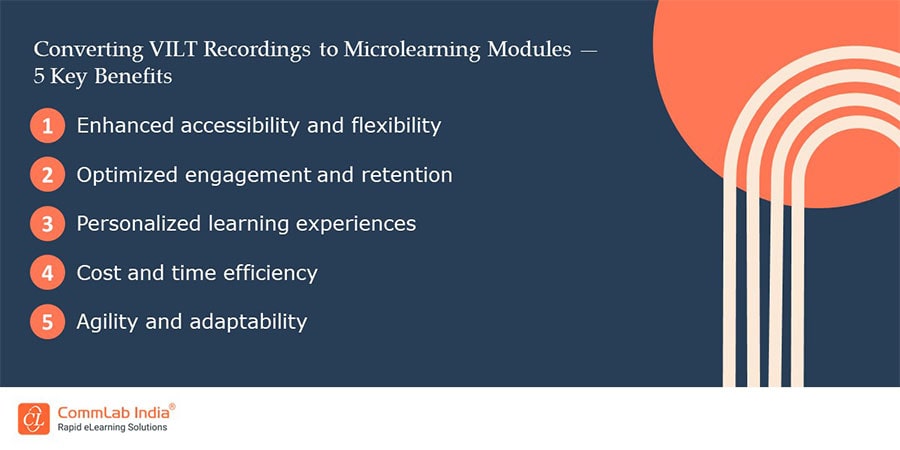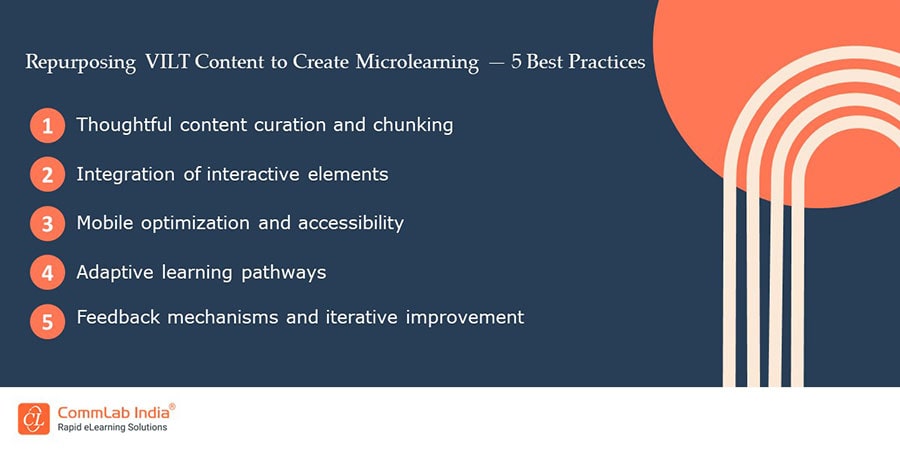Repurpose to Rock: Transform VILT Session Recordings into Engaging Microlearning

Let’s admit it! In today’s dynamic business landscape, the need for continual learning to stay current has increased like never before. On the other hand, cut-throat competition is keeping employees on their toes, struggling with packed calendars. Naturally, training has to be a part of the workflow to help employees acquire knowledge and skills alongside work. Well, crafting interesting learning journeys for employees is not a cakewalk. If you are an L&D strategist or a training manager, you must be resonating with me on that. Well, no more scratching your heads looking for ways to engage learners as well as help improve your training ROI. Try this! Dig out the treasure of old virtual instructor-led training (VILT) session recordings lying unused in your resource library and revamp them into powerful microlearning nuggets.
Read this blog to delve into the significance of repurposing VILT session recordings into engaging microlearning content, offering valuable insights for corporate training initiatives.
Repurpose Your VILT Recordings to Engaging Microlearning
Here are a few formats you can try:
- Short Videos
- Interactive Quizzes and Assessments
- Infographics and Visual Summaries
- Scenario-Based Simulations
- Microlearning Nuggets for Mobile Learning
Read on for benefits and best practices.
What and Why of Microlearning
In the fast-paced corporate world, where time is a precious commodity and attention spans are shrinking, organizations need to relook into their traditional methods of training. Cognitive fatigue is a real concern, especially in conventional training methods where employees are bombarded with information for extended periods. Recognizing this challenge, many organizations are turning to microlearning, a training approach that delivers content in short, focused bursts.
Microlearning breaks down complex topics into easily digestible modules, allowing learners to absorb information more effectively. On top of that, it allows you the scope to choose from a wide variety of formats such as eBooks, videos, interactive PDFs, infographics, digital flashcards, and podcasts to offer immersive learning experiences. Microlearning modules can serve as standalone courses or can be a part of a curriculum. It can also be integrated with other learning formats such as eLearning or virtual instructor-led training under the blended learning umbrella.
→ Download eBook: Microlearning 101
What are the Key Benefits of Converting VILT Recordings to Microlearning Modules
Do more with less is what is expected from L&D leaders. After all the ultimate goal is to maximize learning outcomes and enhance productivity while boosting training ROI. Designing and developing courses from scratch can be costly. Repurposing existing content is a smart way to create new courses with minimal resources. And what better than transforming the VILT session recordings into microlearning modules? o maximize the utility of these sessions, converting VILT session recordings into microlearning modules offers significant advantages for organizations aiming to enhance employee learning outcomes. Let's delve into the five key benefits of this transformative strategy:

-
Enhanced Accessibility and Flexibility
Converting VILT session recordings into microlearning modules provides employees with unparalleled accessibility and flexibility in their learning journey. By breaking down lengthy sessions into bite-sized chunks, employees can conveniently access relevant content at their own pace and on-demand. Whether it's during short breaks, commute time, or downtime between tasks, microlearning modules empower employees to engage with training materials anytime, anywhere, fostering a culture of continuous learning within the organization. -
Optimized Engagement and Retention
Microlearning modules capitalize on the principles of cognitive psychology, maximizing engagement and retention rates among employees. By delivering content in concise and focused segments, learners are less prone to cognitive overload and more likely to retain key information. Moreover, interactive elements such as quizzes, simulations, and case studies can be seamlessly integrated into microlearning modules, further enhancing engagement and reinforcing learning objectives. As a result, organizations witness a significant uptick in knowledge retention and application post-training, translating into tangible improvements in job performance. -
Personalized Learning Experiences
Tailoring learning experiences to individual preferences and skill levels is paramount for driving employee growth and development. Converting VILT session recordings into microlearning modules facilitates personalized learning journeys by allowing employees to choose modules aligned with their specific learning objectives and competency gaps. Furthermore, advanced analytics and tracking mechanisms enable L&D professionals to monitor learner progress, identify areas of improvement, and deliver targeted interventions as needed. This adaptive approach not only boosts learning efficacy but also fosters a sense of empowerment and ownership among employees regarding their professional development. -
Cost and Time Efficiency
Converting VILT session recordings into microlearning modules offers a cost-effective alternative with minimal overheads. By leveraging existing content assets, organizations can repurpose valuable training materials without incurring additional expenses. Moreover, the scalability of microlearning modules allows for rapid deployment across geographically dispersed teams, eliminating the need for extensive coordination and logistics. Consequently, organizations can achieve significant cost savings while maximizing the utilization of their training resources. -
Agility and Adaptability
In today's dynamic business environment, agility and adaptability are indispensable attributes for organizational success. Converting VILT session recordings into microlearning modules equips organizations with the agility to swiftly respond to evolving training needs and market dynamics. Whether it's introducing new product updates, addressing emerging compliance requirements, or upskilling employees to meet changing job roles, microlearning modules enable organizations to deliver timely and targeted training interventions. Furthermore, the modular nature of microlearning facilitates easy updates and revisions, ensuring that training content remains relevant and aligned with organizational objectives.
What Microlearning Formats Can Be Crafted from VILT Session Recordings
Microlearning has revolutionized corporate training by offering compact, focused learning experiences that cater to the needs of modern learners. Repurposing virtual instructor-led training (VILT) session recordings into various microlearning formats enables organizations to deliver targeted, on-demand just-in-time learning opportunities. Here are five microlearning formats that can be crafted from VILT session recordings:
-
Short Videos
Converting VILT session recordings into short videos allows organizations to deliver visual, engaging learning experiences to employees. By extracting key concepts and demonstrations from the sessions, instructional designers can create concise video segments that address specific learning objectives. These video tutorials can range from software demonstrations and process walkthroughs to soft skills training and best practice sharing. With attention-grabbing visuals and clear narration, short video tutorials provide employees with quick access to valuable information, fostering skill development and knowledge retention.
Watch this video to get insights on how to create engaging microlearning videos. -
Interactive Quizzes and Assessments
Transforming VILT session content into interactive quizzes and assessments adds an element of gamification and interactivity to the learning experience. By extracting quiz questions, case studies, or scenario-based challenges from session recordings, organizations can create engaging assessment activities that reinforce learning objectives. Incorporating immediate feedback and scoring mechanisms enhances learner engagement and promotes active participation. Interactive quizzes and assessments not only assess knowledge comprehension but also serve as effective tools for reinforcing learning and identifying areas for improvement. -
Infographics and Visual Summaries
Converting VILT session content into infographics and visual summaries offers a visually appealing way to distill complex information into digestible nuggets. By condensing key concepts, data, and insights into graphical representations, organizations can create visually stimulating resources that aid in information retention and comprehension. Infographics and visual summaries can be used to illustrate processes, timelines, statistics, or comparisons, providing employees with quick reference materials that enhance understanding and facilitate knowledge transfer. With eye-catching design and concise messaging, these visual assets serve as valuable aids for reinforcing learning outcomes. -
Scenario-based Simulations
Crafting scenario-based simulations from VILT session recordings immerses employees in real-world situations, allowing them to apply theoretical knowledge to practical scenarios. By extrapolating scenarios or case studies discussed during VILT sessions, organizations can create interactive simulations that challenge learners to make decisions, solve problems, and explore consequences within a controlled environment. These simulations can cover a wide range of topics, including customer interactions, compliance scenarios, or workplace challenges. By providing a safe space for experiential learning, scenario-based simulations enhance critical thinking skills and decision-making abilities among employees. -
Microlearning Nuggets for Mobile Learning
Packaging VILT session content into microlearning nuggets tailored for mobile learning ensures accessibility and convenience for employees on the go. By breaking down session recordings into bite-sized modules, organizations can deliver targeted learning content that can be easily consumed during short breaks amidst work, or commutes, or leisure. These microlearning nuggets can consist of text-based summaries, audio podcasts, or interactive activities optimized for mobile devices. With offline access capabilities and progress tracking features, mobile-friendly microlearning nuggets empower employees to engage with training materials anytime, anywhere, promoting a culture of continuous learning and skill development.
What Best Practices to Adopt while Repurposing VILT Content to Create Microlearning Lessons
In the realm of corporate learning and development, repurposing virtual instructor-led training (VILT) session recordings into microlearning lessons represents a strategic approach to enhance employee engagement and knowledge retention. To ensure the effective conversion of VILT content into microlearning format, organizations can adopt the following five best practices:

-
Thoughtful Content Curation and Chunking
The first step in repurposing VILT session recordings is content curation and chunking. Rather than transferring entire sessions verbatim, focus on identifying key learning objectives, concepts, and insights. Break down the content into bite-sized chunks, each addressing a specific topic or skill. By maintaining a clear focus on learning outcomes, organizations can ensure that microlearning lessons are concise, relevant, and conducive to effective knowledge transfer. This practice enables employees to digest information in manageable segments, facilitating better understanding and retention. -
Integration of Interactive Elements
Incorporating interactive elements is essential for enhancing learner engagement and interactivity in microlearning lessons. Leverage multimedia tools such as quizzes, simulations, polls, and interactive scenarios to transform passive content into dynamic learning experiences. These interactive elements not only reinforce learning but also encourage active participation and knowledge application. By fostering an immersive learning environment, organizations can maximize learner engagement and promote deeper levels of understanding and skill acquisition among employees. -
Mobile Optimization and Accessibility
In today's mobile-centric work environment, optimizing microlearning lessons for mobile devices is imperative to ensure accessibility and flexibility for employees. Prioritize mobile responsiveness and compatibility across various devices and screen sizes to facilitate seamless access to learning content anytime, anywhere. Incorporate features such as offline access and progress syncing to accommodate learners with limited connectivity or busy schedules. By embracing mobile optimization, organizations empower employees to engage with training materials on their preferred devices, promoting continuous learning and skill development on the go. -
Adaptive Learning Pathways
Embracing adaptive learning pathways is essential for tailoring microlearning lessons to individual learning styles, preferences, and proficiency levels. Utilize advanced analytics and learner data to personalize learning experiences and suggest apt content based on learner progress and performance. Implement branching scenarios and personalized learning paths to cater to diverse learning needs and address specific competency gaps effectively. By providing adaptive learning experiences, organizations can optimize learning outcomes, boost learner motivation, and foster a culture of continuous improvement and skill development. -
Feedback Mechanisms and Iterative Improvement
Continuous feedback and iterative improvement are critical components of an effective microlearning strategy. Implement feedback mechanisms such as surveys, quizzes, and assessments to gather insights on learner satisfaction, comprehension, and effectiveness of microlearning lessons. Analyze feedback data to identify areas for improvement and refine microlearning content accordingly. Embrace a culture of experimentation and iteration, where feedback is leveraged to enhance the relevance, efficacy, and impact of microlearning lessons over time. By prioritizing continuous improvement, organizations can ensure that microlearning initiatives remain aligned with evolving learning needs and organizational objectives.
The Way Ahead — Repurpose to Rock
Incorporating microlearning into corporate training initiatives offers a strategic solution to combat cognitive fatigue and enhance learning outcomes. By repurposing VILT session recordings into engaging microlearning modules, organizations can deliver targeted, accessible, and cost-effective training experiences that resonate with modern learners. Embracing the versatility of microlearning formats and adhering to best practices ensures that repurposed content not only captivates but also empowers employees to acquire and apply knowledge effectively, driving business success in the digital age.
Bonus! Here’s an eBook that’ll help you understand where microlearning fits in your learning strategy. Grab your copy now!




![Remote Onboarding: Do We Hear You Say Yay or Nay? [SlideShare]](https://blog.commlabindia.com/hubfs/Imported_Blog_Media/remote-onboarding-pros-cons-corporate-training-slideshare.jpg)
